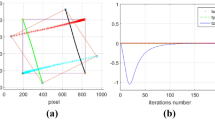Abstract
A novel approach to visual servoing is presented, which takes advantage of the structure of the Lie algebra of affine transformations. The aim of this project is to use feedback from a visual sensor to guide a robot arm to a target position. The target position is learned using the principle of ‘teaching by showing’ in which the supervisor places the robot in the correct target position and the system captures the necessary information to be able to return to that position. The sensor is placed in the end effector of the robot, the ‘camera-in-hand’ approach, and thus provides direct feedback of the robot motion relative to the target scene via observed transformations of the scene. These scene transformations are obtained by measuring the affine deformations of a target planar contour (under the weak perspective assumption), captured by use of an active contour, or snake. Deformations of the snake are constrained using the Lie groups of affine and projective transformations. Properties of the Lie algebra of affine transformations are exploited to provide a novel method for integrating observed deformations of the target contour. These can be compensated with appropriate robot motion using a non-linear control structure. The local differential representation of contour deformations is extended to allow accurate integration of an extended series of small perturbations. This differs from existing approaches by virtue of the properties of the Lie algebra representation which implicitly embeds knowledge of the three-dimensional world within a two-dimensional image-based system. These techniques have been implemented using a video camera to control a 5 DoF robot arm. Experiments with this implementation are presented, together with a discussion of the results.
Similar content being viewed by others
References
Bard, C., Laugier, C., Milési-Bellier, C., Troccaz, J., Triggs, B., and Vercelli, G. 1995. Achieving dextrous grasping by integrating planning and vision-based sensing. International Journal of Robotics Research, 14(5):445–464.
Basri, R., Rivlin, E., and Shimshoni, I. 1998. Visual homing: Surfing on the epipoles. In Proceedings of International Conference on Computer Vision (ICCV' 98), pp. 863–869.
Cipolla, R., and Blake, A. 1997. Image divergence and deformation from closed curves. International Journal of Robotics Research, 16(1):77–96.
Colombo, C. and Allotta, B. 1999. Image-based robot task planning and control using a compact visual representation. IEEE TSystems, Man and Cybernetics (B), 29(1):92–100.
Corke, P. and Goode, M. 1996. Dynamic effects in visual closed-loop systems. IEEE T-Robotics and Automation, 12(5):671–683.
Couvignon, P., Papanikolopoulos, N., Sullivan, M., and Khosla, P. 1996. The use of active deformable models in model-based robotic visual servoing. Journal of Intelligent and Robotic Systems, 17(2):195–221.
Cross, G. and Cipolla, R. 1996. Affine visual servoing. In Proceedings of British Machine Vision Conference (BMVC' 96), Edinburgh, Vol. 2, pp. 425–434.
Espiau, B., Chaumette, F., and Rives, P. 1992. A new approach to visual servoing in robotics. IEEE T-Robotics and Automation, 8(3):313–326.
Hager, G. and Hutchinson, S. 1996. Introduction to special section on vision-based control of robotic manipulators. IEEE T-Robotics and Automation, 12(5):649–650.
Horaud, R. and Dornika, F. 1995. Hand-eye calibration. International Journal of Robotics Research, 14(3):195–210.
Hutchinson, S., Hager, G., and Corke, P. 1996. A tutorial on visual servo control. IEEE T-Robotics and Automation, 12(5):651–670.
Isard, M. and Blake, A. 1996. Visual tracking by stoachastic propagation of conditional density. In Proceedings of the 4th European Conference on Computer Vision, pp. 343–356.
Kass, M., Witkin, A., and Terzopoulous, D. 1988. Snakes: Active contour models. International Journal of Computer Vision, 1(4):321–331.
Kinoshita, K. 1998. Robotic control with partial visual information. In Proceedings of International Conference on Computer Vision (ICCV' 98), pp. 883–888.
Koenderink, J.J. and van Doorn, A.J. 1975. Invariant properties of the motion parallax field due to movement of rigid bodies relative to an observer. Optica Acta, 22(9):773–791.
Malis, E., Chaumette, F., and Boudet, S. 1999. 2 1/2 D visual servoing. IEEE T-Robotics and Automation, 15:234–246.
Murray, R. and Sastry, S. 1994. A Mathematical Introduction to Robotic Manipulation. CRC Press: London.
Nayar, S., Nene, S., and Murase, H. 1996. Subspace methods for robot vision. IEEE T-Robotics and Automation, 12(5):750–758.
Park, F., Barrow, J., and Ploen, S. 1995. A Lie group formulation of robot dynamics. International Journal of Robotics Research, 14(6):609–618.
Sanderson, A., Weiss, L., and Neumann, C. 1987. Dynamic sensor based control of robots with visual feedback. IEEE Journal of Robotics and Automation, 3:404–417.
Santos-Victor, J., Sandini, G., Curotto, F., and Garibaldi, S. 1995 Divergent stereo in autonomous navigation: From bees to robots. International Journal of Computer Vision, 14:159–177.
Sattinger, D. and Weaver, O. 1986. Lie Groups and Algebras with Applications to Physics, Geometry, and Mechanics, Springer-Verlag. Applied Mathematical Sciences, Vol. 61.
Varadarajan, V.S. 1974. Lie Groups, Lie Algebras and Their Representations, Springer-Verlag. Graduate Texts in Mathematics, Vol. 102. Published in Berlin.
Wilson, W.J., Williams Hulls, C.C., and Bell, G.S. 1996. Relative end-effector control using cartesian position based visual servoing. IEEE T-Robotics and Automation, 12(5):684–696.
Yoshimi, B.H. and Allen, P.K. 1995. Alignment using an uncalibrated camera system. IEEE T-Robotics and Automation, 11(4):516–521.
Author information
Authors and Affiliations
Rights and permissions
About this article
Cite this article
Drummond, T., Cipolla, R. Application of Lie Algebras to Visual Servoing. International Journal of Computer Vision 37, 21–41 (2000). https://doi.org/10.1023/A:1008125412549
Issue Date:
DOI: https://doi.org/10.1023/A:1008125412549




